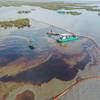ex-USS Oriskany to Serve as Artificial Reef
The ex-USS Oriskany (CVA 34), the last Essex-class aircraft carrier in the fleet’s inactive ship inventory, served the Navy for more then 25 years, maintaining a powerful presence during the Korean War and the Vietnam conflict. Decommissioned September 1976, the ship is ready to do more sea time, only this time beneath the surface, serving as an artificial reef. “Artificial reefing benefits the economical environment of the respective state receiving the ship by relieving stress on the natural reef,” said Capt. Lawrence M. Jones Jr., program manager for the Inactive Ships Program Office, Naval Sea Systems Command (NAVSEA). “The program also saves tax dollars, which can be recycled into newer technology.” With its own inventory of 97 obsolete vessels designated for disposal, the Maritime Administration (MARAD) is the government's disposal agent for merchant type vessels of 1,500 gross tons or more, including Navy non-combatants that had previously been title-transferred to MARAD. As MARAD has had statutory authority since 1972 to donate obsolete vessels to states for sinking as artificial reefs, NAVSEA and MARAD worked together to develop a common process for the donation of "federal" ships for artificial reefing. Each agency, however, will donate its own vessels under its own statutory authority, which the Navy obtained in the FY04 National Defense Authorization Act. In partnership with MARAD, NAVSEA will approve one state’s application for the ex-Oriskany to become part of its ecological system in the form of an artificial reef. Jones has the all-encompassing task of selecting the state to receive the ex-Oriskany, evaluating the applicants' plans for the use and management of the reef area. Additionally, he monitors site permits by the Army Corps of Engineers; a state’s willingness to cost-share in towing, sinking and ship’s modifications; plans fostering naval or maritime heritage; amount of political and public support; adherence to the National Fishing Enhancement Act; economic and environmental studies done; and any impact on national marine sanctuaries or natural coral reef areas. Four states have applied for the ex-USS Oriskany; Florida, Mississippi, Texas, and a joint application by Georgia and South Carolina. Jones noted that an applicant’s willingness to cost-share is one of the factors in the final selection. The Reefing Program is budget driven, Jones explained. “Artificial reefing and remediation are about one fourth the cost of totally dismantling and recycling a ship.” Jones continued, “The reefing area could also be designated by the receiving state as a memorial or an historical site and benefit the state through tourism, much like the USS Missouri (BB 63) Memorial in Hawaii.” Although historical artifacts had previously been removed for the Curator of the Navy and other materials had been removed by the Oriskany Museum of Oriskany, N.Y., the ship's memory will be further preserved by removing of a section of the wood deck and the ship’s name from the transom during environmental preparation work ongoing in Corpus Christi, Texas. These materials will be sent to the National Museum of Naval Aviation, Pensacola, Fla. The Inactive Ship Program currently has an additional 24 ships available for reefing. Jones’ goal is to move a third of the 24 ships this year. Source: NAVnews











